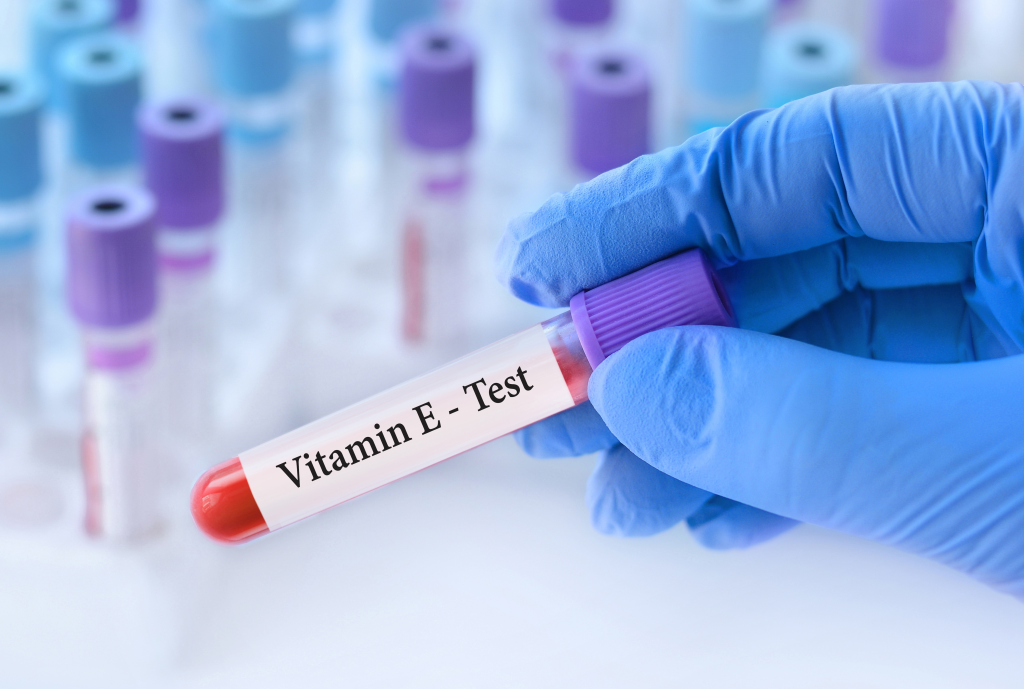At a glance
Vitamin E is a fat-soluble nutrient found in both plant and animal foods that supports cellular protection and overall health. It functions as a powerful antioxidant, helping protect fats and cell membranes from oxidative stress. Found in oils, nuts, seeds, and leafy greens, vitamin E promotes heart, brain, and immune health and helps maintain healthy skin, vision, and energy levels.
What is vitamin E, and how much do you need to support a healthy body?
Vitamin E is an essential fat-soluble vitamin that helps maintain cellular functions, supports heart health, and promotes balanced cholesterol levels.
Discover six impressive health benefits of consuming vitamin E-rich foods and learn how to maintain optimal levels of this crucial nutrient through natural sources.
What is vitamin E?
Vitamin E is a fat-soluble nutrient that belongs to the same group as vitamins A, D, and K. Rather than being one single nutrient, vitamin E is actually a family of eight structurally similar compounds.
Its chemical structure is based on a chromanol ring, which is linked to vitamin E’s antioxidant properties. This ring is attached to a side chain with hydrophobic properties, enabling vitamin E to dissolve readily in lipids and fats.
This unique structure allows vitamin E to integrate into cell membranes, where it supports and strengthens the body’s capacity to protect lipids from oxidation.
These cellular antioxidant properties are believed to explain why a diet rich in natural vitamin E may play a role in the prevention of cardiovascular disease and vision loss, as well as various forms of cancer.
Types of vitamin E
Vitamin E is divided into tocopherols and tocotrienols, each occurring in an alpha, beta, gamma, and delta form.
All eight forms of the vitamin E complex have similar chemical structures, sharing a chromanol ring and hydrophobic tail.
However, each form differs in the number and position of methyl groups on the ring and in the saturation of their tail, which affects how they function and are absorbed.
Research published in Biomedicine & Pharmacotherapy highlights that while alpha-tocopherol is considered the most biologically active form of vitamin E in the human body, gamma-tocopherol and tocotrienols may also play critical roles in supporting health.1
Watch the video below to learn why vitamin E is crucial for overall health and well-being.
Health benefits of vitamin E
In contrast to water-soluble antioxidants such as vitamin C or beta-carotene, vitamin E is fat-soluble, which allows it to cross cellular membranes. This provides unique cellular protection and distinct health advantages within the body.
Here are six benefits of vitamin E.
1. Enhances the body’s antioxidant capacity
One of the most significant benefits of vitamin E is its ability to act as an antioxidant, protecting lipid structures in cells and tissues from oxidative damage caused by free radicals.
Free radicals are highly-unstable metabolic byproducts that can damage cellular components, including the mitochondria, DNA, and other genetic material.
This may explain why a diet rich in vitamin E has been linked with a lower risk of developing certain types of cancer.
A report published by the American Institute for Cancer Research (AICR) highlights that women who consume around 14 mg of vitamin E per day from natural food sources had a lower risk of lung cancer than those who didn’t consume adequate amounts.2
Vitamin E’s potent antioxidant properties also support liver health as liver cells are exposed to high levels of free radicals due to their critical roles in energy metabolism and detoxification.
A study published in Nature investigated the link between vitamin E and the risk of developing nonalcoholic fatty liver disease (NAFLD) and concluded, “Augmenting dietary intake of vitamin E proves advantageous in the prevention of NAFLD.”3

2. Supports cardiovascular health
Vitamin E plays a crucial role in protecting the integrity of blood vessels, which is vital for maintaining a healthy cardiovascular system.
Its antioxidant effects help prevent the oxidation of low-density lipoprotein (LDL) cholesterol, which may reduce the risk of atherosclerosis, a significant factor contributing to serious cardiovascular events such as stroke or heart attack.
By limiting LDL cholesterol oxidation, vitamin E may contribute to healthier lipid levels and better cardiovascular functions.
3. Promotes neuronal and cognitive health
The brain and central nervous system are primarily composed of lipid-rich tissues, making them especially susceptible to oxidative stress.
Vitamin E helps protect these delicate structures from free radical damage that can impair cell function and communication.
Adequate dietary vitamin E intake has been associated with better memory, cognitive performance, and slower age-related mental decline.
In fact, evidence published in the International Journal of Molecular Sciences found that a higher consumption of vitamin E-rich foods has been linked to a lower risk of age-related mild cognitive impairment as well as Alzheimer’s disease.4

4. Strengthens immune functions
Immune cells utilize oxidative processes, known as an oxidative burst, to eliminate pathogens such as bacteria, viruses, and other microbes.
Vitamin E can support these processes by protecting immune cells from the harmful effects of this oxidative burst. This helps maintain the integrity and efficiency of immune responses, enhancing the body’s ability to fight infections and maintain balanced inflammatory regulation.
5. Helps maintain healthy vision
Vitamin E has been studied for its potential role in protecting the delicate structures within the retina, which are especially susceptible to oxidative damage due to constant light exposure.
Research published in Food Chemistry: Molecular Science suggests that vitamin E helps preserve retinal cell integrity by minimizing oxidative stress, which may help reduce the risk of developing age-related vision problems such as macular degeneration and cataracts.5
6. Supports skin health and wound healing
Vitamin E is a common ingredient in skincare products due to its antioxidant and moisturizing properties.
It helps protect the skin from oxidative damage, supports the repair of damaged tissue, and promotes faster wound healing.
In addition, vitamin E may help reduce the appearance of scar tissue by improving skin elasticity and encouraging healthier skin regeneration.

How much vitamin E do you need?
According to data published by the National Institutes of Health (NIH), the recommended dietary reference intakes for vitamin E from food sources are set at 15 mg per day for individuals aged 14 and older.6
Children between the ages of 9 and 13 should aim for 11 mg of vitamin E daily, and breastfeeding women are advised to obtain 19 mg per day to meet the heightened nutritional needs of the infant and mother.
However, individuals with malabsorption issues due to celiac disease, Crohn’s disease, and poor liver function may require additional vitamin E to maintain optimal levels.
In addition, those following low-fat diets may be at risk of inadequate vitamin E absorption and should consider consulting a healthcare professional to ensure their nutritional needs are met.

Vitamin E deficiency symptoms and causes
Although vitamin E is found in many foods, certain dietary habits, lifestyle factors, and digestive issues can interfere with vitamin E absorption and lead to inadequate body stores.
Here are common signs and symptoms of vitamin E deficiency:
- Muscle weakness and fatigue
- Frequent infections
- Changes in vision
- Tingling or numbness in hands and feet
- Dry skin
- Balance issues
- Poor cognitive function
While relatively rare, a severe vitamin E deficiency can cause impaired vision, muscle degeneration, nerve damage, and significant neurological problems.
“Because vitamin E is fat-soluble, it’s primarily found in foods rich in oils and healthy fats,” explains Dr. Berg. “As a result, following a very low-fat diet is one of the leading dietary causes of vitamin E deficiency.”
A high-carb diet has also been linked to lower vitamin E status, possibly due to the pro-oxidant effects of carbohydrate metabolism. This increases oxidative stress and contributes to the depletion of antioxidant nutrients such as vitamin E.
In addition, a study published in Nutrients found a link between low vitamin E status, obesity, and metabolic imbalances. This may be due to increased oxidative stress and inflammation commonly seen in obesity, which can further deplete vitamin E stores.
The authors conclude, “These results reveal that the vitamin E status of adults with excess body fat may be inadequate and linked to poorer metabolic health.”
Other potential contributing factors of vitamin E deficiency include:
- Smoking
- Regular alcohol consumption
- Bile salt deficiency
- Fat malabsorption
- Diet high in ultra-processed foods
- Chronic inflammation

The best natural sources of vitamin E
Lipid-rich plant foods, such as nuts and seeds, naturally produce vitamin E to help protect their cell membranes from the oxidative effects of sunlight and oxygen exposure.
Animals that consume these plants absorb vitamin E through their diet, incorporating it into their own tissues, particularly in fat stores, the liver, and cell membranes.
This explains why plant foods are considered primary vitamin E sources, while animal sources are secondary and typically contain lower concentrations.
Plant oils are among the best sources of this essential mineral as they’re highly concentrated extracts from the vitamin E-rich seeds and germ of plants.
Here’s the vitamin E content of various oils per 1 tablespoon:
- Wheat germ oil: 20 mg
- Hazelnut oil: 6.4 mg
- Almond oil: 5.3 mg
- Avocado oil: 2.1 mg
Seeds and nuts are also significant sources of vitamin E, especially sunflower seeds, which offer an impressive 7.4 mg per 1-oz (28-gram) serving, and almonds, which contain 6.8 mg per 1 oz.
While hazelnuts, pine nuts, peanuts, and pistachios don’t provide as much vitamin E as sunflower seeds or almonds, regularly consuming them can contribute to healthy vitamin E levels, especially when incorporated into a varied, nutrient-rich diet.
Other notable sources of vitamin E include:
- Oily fish such as salmon or tuna
- Egg yolks
- Grass-fed butter
- Goose fat
In addition, leafy greens such as spinach, Swiss chard, and kale provide moderate amounts of vitamin E.
Cooking these vegetables enhances the bioavailability and absorption of vitamin E, especially when prepared with healthy fats such as ghee, butter, or olive oil. Thus, leafy greens are an excellent addition to a vitamin-E-focused diet.
Key takeaways
- Vitamin E is a fat-soluble nutrient made up of eight compounds, including tocopherols and tocotrienols, that work together to protect the body’s cells from oxidative stress.
- Its antioxidant properties help maintain the stability of cell membranes, support cardiovascular and brain health, and promote skin, eye, and immune function.
- Found mainly in plant oils, nuts, seeds, and leafy greens, vitamin E helps protect fats in the body from oxidation and supports overall cellular health.
FAQ
What is vitamin E good for?
Vitamin E is a fat-soluble vitamin with potent antioxidant properties that help protect the body’s lipid-rich structures, such as the brain, neurons, cell membranes, and skin, from oxidative damage.
It also supports balanced immune function and cardiovascular health, and may aid in maintaining healthy vision and hormone balance.
What food is highest in vitamin E?
Wheat germ oil is the most concentrated source of vitamin E, offering an impressive 20 mg per tablespoon. Other foods rich in vitamin E include hazelnut oil, avocado oil, sunflower seeds, and almonds.
What are the symptoms of a vitamin E deficiency?
Signs and symptoms of a vitamin E deficiency include muscle weakness, frequent infections, skin problems, neuropathy, and brain fog.
Is it possible to get too much vitamin E from food?
No, it’s generally not possible to get too much dietary vitamin E, as the body naturally regulates intestinal absorption from whole foods.
What is the best form of vitamin E?
Alpha-tocopherol is generally considered the most active and well-absorbed form of vitamin E found in abundance in plant-based foods such as nuts and seeds.
Sources
- https://www.sciencedirect.com/science/article/abs/pii/S0753332205001368?via%3Dihub ?
- https://www.aicr.org/resources/blog/study-vitamin-e-from-food-not-supplements-may-lower-womens-lung-cancer-risk/ ?
- https://www.nature.com/articles/s41598-024-52482-w ?
- https://pmc.ncbi.nlm.nih.gov/articles/PMC5751107/ ?
- https://pmc.ncbi.nlm.nih.gov/articles/PMC11481750/ ?
- https://ods.od.nih.gov/factsheets/VitaminE-HealthProfessional/ ?








